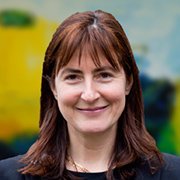Chiara Bisagni
The fact that composites are lighter than aluminium alloys places them as one of the main players when it comes to reducing environmental impacts. In aeronautics and space transportation, as well as many other sectors, the lighter a vehicle, the more energy-efficient it is. For this reason, but also out of pure curiosity, Chiara Bisagni, Professor of Aerospace Structures and Computational Mechanics, puts her heart and soul into her work on composite structures.
Bisagni and her team develop composite structures for lightweight applications in aeronautics and space transportation as well as the automobile, shipping and wind-turbine industries. “Lighter structures result in lower fuel consumption, reduced CO2 emissions and, ultimately, less pollution. This makes them more sustainable than the materials we currently use in aircraft, ships and cars.”
Before composite can be applied on a large scale, there is still a lot to be learned. “We are researching how composite structures behave, how they can be optimised and how damage can be predicted and prevented. It's still not known how composite materials break, which is why we are researching the emergence of fractures and the ways they spread in composite structures. We are also examining fatigue, a key issue in the case of a vehicle subjected to repeated load cycles, which affect its lifespan.”
Bisagni, who was born and raised in Italy, has devoted her life to composite structures since her doctoral research and Master's degree programme at the Politecnico di Milano. It has been her key area of focus as assistant/associate professor at the Politecnico di Milano, as visiting associate professor at MIT, during her professorship at the University of California San Diego and as professor at TU Delft since 2015. She has won several prizes and fellowships, including an Amelia Earhart Fellowship, a Marie Curie Fellowship, a Fulbright Grant and an Erasmus Mundus Fellowship.
Composites are light in weight and as a result a major player in reducing environmental impacts.
Chiara Bisagni
Increasingly fascinating
“I was mad about maths as a child and was really attracted to the ideas of Archimedes. I decided to study aerospace engineering, even though I knew nothing about it. But in the course of the programme, and later in my career, I found it increasingly fascinating. I particularly love the research work. I am inquisitive, adore the unknown and enjoy conducting lab tests.”
Teaching and supervising students is another passion for the professor. “It's great to have the honour of passing on my knowledge and enthusiasm for the subject. The international aspect of my work, both within TU Delft and beyond it, also appeals to me. We are working with NASA Langley on improvements to composite structures for space transportation, for the development of new launchers, for example. We are also participating in many EU projects in aeronautics and there is close international collaboration with composite scientists in such countries as China.”
Lighter and more sustainable composites may be seen as great progress, but recycling is still an open issue. Besides, safety is equally important. “It's a very tricky area. This is why we are searching hard for the optimum combination of the best materials and best design. For this, we carry out crash modelling and testing on aircraft and cars. One of the great properties of composite materials is that they can absorb energy effectively, better than metals. It's no coincidence that composite materials are now already being used in the Airbus A350 and the Boeing 787, for example.”
In the field of testing, a lot is changing. “Every structure in aviation has to be subjected to experimental testing, but there is a tendency to limit the number of real-life tests. Instead, we use numerical analysis and virtual testing. This is not only advantageous in terms of costs, but also because you can find out more in a short space of time. That increased knowledge means more opportunities. Also in terms of sustainability, it helps us to develop more sustainable composites.”
Like everyone else, the professor also sees sustainability as personally important. “I usually don't drive a car, especially here in the Netherlands, doing everything by bike. But my main contribution is actually through my specialist field. Everything that we do with composites in aeronautics and space transportation has a spin-off in many other sectors. Thanks to composites, it's possible to make electric cars – with the heavy batteries needed, steel cars are far too heavy – and they are 100% clean. Apply this development in other fields, such as the shipping and wind-turbine industries, or actually anywhere where reducing weight plays a role. The potential benefits for the environment are amazing.”


